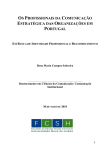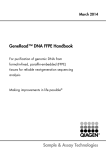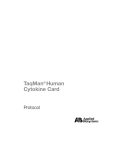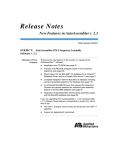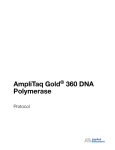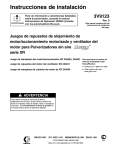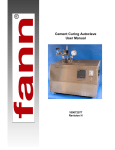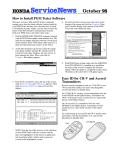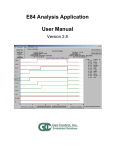Download TaqMan® Exogenous Internal Positive Control
Transcript
TaqMan® Exogenous Internal Positive Control Reagents VIC™ Probe Protocol © Copyright 2001, Applied Biosystems For Research Use Only. Not for use in diagnostic procedures. All rights reserved. Printed in the U.S.A. NOTICE TO PURCHASER: DISCLAIMER OF LICENSE This product is optimized for use in the Polymerase Chain Reaction (“PCR”) and 5´ nuclease detection methods covered by patents owned by Roche Molecular Systems, Inc. and F. Hoffmann-La Roche Ltd. No license under these patents to use the PCR process or 5´ nuclease detection methods is conveyed expressly or by implication to the purchaser by the purchase of this product. A license to use the PCR process for certain research and development activities accompanies the purchase of certain Applied Biosystems reagents when used in conjunction with an authorized thermal cycler, or is available from Applied Biosystems. Further information on purchasing licenses to practice the PCR process may be obtained by contacting the Director of Licensing at Applied Biosystems, 850 Lincoln Centre Drive, Foster City, California 94404 or at Roche Molecular Systems, Inc.,1145 Atlantic Avenue, Alameda, California 94501. ABI PRISM, Applied Biosystems and MicroAmp are registered trademarks of Applera Corporation or its subsidiaries in the U.S. and certain other countries. AmpErase, GeneAmp, and TaqMan are registered trademarks of Roche Molecular Systems, Inc. All other trademarks are the sole property of their respective owners. Contents Introduction . . . . . . . . . . . . . . . . . . . . . . . . . . . . . . . . . . . . . . . . . . . . . . . . . . . .1 Purpose of the Kit . . . . . . . . . . . . . . . . . . . . . . . . . . . . . . . . . . . . . . . . . .1 Simultaneously Amplifying Two DNAs . . . . . . . . . . . . . . . . . . . . . . . . .1 Interpreting Negative Results . . . . . . . . . . . . . . . . . . . . . . . . . . . . . . . . .2 Custom Applications. . . . . . . . . . . . . . . . . . . . . . . . . . . . . . . . . . . . . . . .2 End Point Detection and Post-PCR Plate Read . . . . . . . . . . . . . . . . . . .3 Sequence Detection. . . . . . . . . . . . . . . . . . . . . . . . . . . . . . . . . . . . . . . . .3 Materials and Equipment. . . . . . . . . . . . . . . . . . . . . . . . . . . . . . . . . . . . . . . . . .4 Kit Contents . . . . . . . . . . . . . . . . . . . . . . . . . . . . . . . . . . . . . . . . . . . . . .4 Core Kits Supplied by the User . . . . . . . . . . . . . . . . . . . . . . . . . . . . . . .4 Materials Supplied by User. . . . . . . . . . . . . . . . . . . . . . . . . . . . . . . . . . .5 Storage and Stability . . . . . . . . . . . . . . . . . . . . . . . . . . . . . . . . . . . . . . . .6 Preparing Reactions and Thermal Cycling . . . . . . . . . . . . . . . . . . . . . . . . . . . .7 Introduction. . . . . . . . . . . . . . . . . . . . . . . . . . . . . . . . . . . . . . . . . . . . . . .7 About Preparing Reactions . . . . . . . . . . . . . . . . . . . . . . . . . . . . . . . . . . .7 Thermal Cycling . . . . . . . . . . . . . . . . . . . . . . . . . . . . . . . . . . . . . . . . . . .8 Performing End Point Detection on the ABI PRISM 7200 or 7700 . . . . . . . . . .9 Overview. . . . . . . . . . . . . . . . . . . . . . . . . . . . . . . . . . . . . . . . . . . . . . . . .9 Setting up the Software. . . . . . . . . . . . . . . . . . . . . . . . . . . . . . . . . . . . . .9 Setting Up the Plates . . . . . . . . . . . . . . . . . . . . . . . . . . . . . . . . . . . . . . . . . . . .10 Overview. . . . . . . . . . . . . . . . . . . . . . . . . . . . . . . . . . . . . . . . . . . . . . . .10 FAM Layer . . . . . . . . . . . . . . . . . . . . . . . . . . . . . . . . . . . . . . . . . . . . . .10 VIC Layer . . . . . . . . . . . . . . . . . . . . . . . . . . . . . . . . . . . . . . . . . . . . . . .11 Analyzing Data for End Point Runs . . . . . . . . . . . . . . . . . . . . . . . . . . . . . . . .13 Analyzing Data . . . . . . . . . . . . . . . . . . . . . . . . . . . . . . . . . . . . . . . . . . .13 Target Template Calls . . . . . . . . . . . . . . . . . . . . . . . . . . . . . . . . . . . . . .14 i Technical Support . . . . . . . . . . . . . . . . . . . . . . . . . . . . . . . . . . . . . . . . . . . . . . 15 Contacting Technical Support . . . . . . . . . . . . . . . . . . . . . . . . . . . . . . . 15 To Contact Technical Support by E-Mail. . . . . . . . . . . . . . . . . . . . . . . 15 Hours for Telephone Technical Support. . . . . . . . . . . . . . . . . . . . . . . . 15 To Contact Technical Support by Telephone or Fax . . . . . . . . . . . . . . 16 To Reach Technical Support Through the Internet . . . . . . . . . . . . . . . 19 To Obtain Documents on Demand . . . . . . . . . . . . . . . . . . . . . . . . . . . . 20 Appendix A. Preventing Contamination . . . . . . . . . . . . . . . . . . . . . . . . . . . . 21 Introduction . . . . . . . . . . . . . . . . . . . . . . . . . . . . . . . . . . . . . . . . . . . . . 21 AmpErase UNG . . . . . . . . . . . . . . . . . . . . . . . . . . . . . . . . . . . . . . . . . . 21 General PCR Practices . . . . . . . . . . . . . . . . . . . . . . . . . . . . . . . . . . . . . 22 Appendix B. References . . . . . . . . . . . . . . . . . . . . . . . . . . . . . . . . . . . . . . . . 23 ii Introduction Purpose of the Kit The TaqMan® Exogenous Internal Positive Control Reagents is a preoptimized internal positive control (IPC) which can be spiked into samples to distinguish true target negatives from PCR inhibition. The kit is designed to: ♦ Distinguish types of negative results A negative call for the target sequence and positive call for the IPC indicates that no target sequence is present A negative call for the target sequence and negative call for the IPC suggests PCR inhibition ♦ Avoid amplification of endogenous genes ♦ Permit coamplifcation of the IPC and the target sequence without compromising amplification of the target sequence ♦ Perform optimally with the TaqMan® Universal PCR Master Mix IMPORTANT To obtain +/– assignments with a 99.7% confidence level, a post-PCR plate read should always be performed. Real time (+/–) document assignments on the ABI PRISM 7700 Sequence Detector have not been verified to be statistically significant. Simultaneously By using the TaqMan Exogenous Internal Positive Control Reagents, a Amplifying Two low-copy target DNA can be amplified in the same tube with the IPC. DNAs Although the target and IPC DNAs may differ in initial copy number, the amplification efficiency of the target reaction is not compromised. This is achieved by limiting the concentration of IPC primers in the PCR reaction. In the PCR reaction the IPC is detected using a VIC-labeled probe and the target template is detected using a FAM-labeled probe. 1 Interpreting The TaqMan Exogenous Internal Positive Control Reagents, in Negative Results conjunction with your target system, identify samples that are positive and negative for a specific target sequence. The kit distinguishes between two types of negative reactions: ♦ Samples identified as negative because they lack the target sequence ♦ Samples identified as negative because of the presence of a PCR inhibitor During amplification, the sample and IPC generate reporter fluorescence signals such that identification calls may be made on unknown samples. Positive and negative calls are made on the basis of statistical analysis of data from the two dye layers. The statistical analysis sets up threshold values for positive FAM and VIC calls on the basis of the No Template Control (NTC) and the Negative Internal Positive Control (IPC–) baselines. In this kit, the FAM layer shows the positive ( +) and negative (–) calls for the target template and the VIC layer shows the +/– calls for the IPC. The target template calls are made on the following basis: If the Detectable Target Template (FAM) call is... And the Detectable IPC (VIC) call is... Then the Target Template is... + +, – a + – + – – – No Amp / ? a. In the presence of a strong FAM signal for the target assay, a negative assignment and/or signal can be obtained in the VIC layer. This is a result of the limiting primer concentrations used in the IPC assay. Custom The IPC DNA, primers, and probes supplied with this kit can be used Applications with all sample target systems. Refer to the TaqMan Universal PCR Master Mix Protocol (P/N 4304449) for instructions on how to optimize your target system’s performance. 2 End Point Detection and Post-PCR Plate Read The TaqMan Exogenous Internal Positive Control Reagents are designed for Plate Read (end point) detection only. Plate Read detection collects one fluorescent scan per tube after PCR is completed. The TaqMan Exogenous Internal Positive Control Reagents are designed to utilize the post-PCR plate read function. Utilization of the pre-PCR plate read may interfere with the ability of the system to make accurate +/– assignments for any specific target. Plate read detection is performed using the following instruments: ♦ ABI PRISM® 7700 Sequence Detection System ♦ ABI PRISM® 7200 Sequence Detection System Sequence The Sequence Detection Systems from Applied Biosystems are used to Detection measure the increase of reporter fluorescence following PCR. Reporter signals are normalized to the emission of a passive reference: Rn (TT) = Rn (IPC) = Emission Intensity of Target Template Sequence Emission Intensity of Passive Reference Emission Intensity of Internal Positive Control Emission Intensity of Passive Reference 3 Materials and Equipment Kit Contents The TaqMan Exogenous Internal Positive Control Reagents (P/N 4308323) provide sufficient material to perform two hundred 50-µL reactions. There is enough 10X Block for twenty-four 50-µL reactions. The kit contents are listed in the table below. Component Volume Description 10X Exo IPC Mix 1.0 mL One tube containing IPC primers and probe. 10X Exo IPC Block 120 µL One tube containing enough blocking reagent for twenty-four 50-µL reactions. 50X Exo IPC DNA 200 µL One tube of IPC template DNA. IMPORTANT The TaqMan VIC dye must be configured as a Pure Dye on the ABI PRISM® 7700/7200 Sequence Detection Systems for it to appear on the Reporter pull-down menu. See User Bulletin #4: Generating New Spectra Components (P/N 4306234) pages 6-7 to configure TaqMan VIC as a Pure Dye. Core Kits Supplied One of the TaqMan core reagent kits listed in the following table is by the User required in addition to the reagents supplied in the TaqMan Exogenous Internal Positive Control Reagents. The Exogenous IPC Reagents have been optimized with the TaqMan Universal PCR Master Mix. 4 Application TaqMan Core Reagents Source PCR TaqMan Universal PCR Master Mix Applied Biosystems (P/N 4304437) TaqMan® PCR Core Reagents Applied Biosystems (P/N N808-0228) Materials Supplied The items listed in the following tables are required in addition to the by User reagents supplied. Equipment Item Source ABI PRISM 7700 Sequence Detection System See your local Applied Biosystems’ representative for the instrument best suited to meet your needs. ABI PRISM 7200 Sequence Detection System/GeneAmp® PCR System 9600 Product Source Custom TaqMan Probes Applied Biosystems 5,000 pmol 15,000–25,000 pmol 50,000–100,000 pmol (P/N 450025) (P/N 450024) (P/N 450003) MicroAmp® Optical 96-Well Reaction Plate and Optical Caps Applied Biosystems (P/N 403012) MicroAmp Optical 96-Well Reaction Plate Applied Biosystems (P/N N801-0560) MicroAmp Optical Tubes Applied Biosystems (P/N N801-0933) MicroAmp Optical Caps Applied Biosystems (P/N N801-0935) Deionized water or TE buffer (10 mM Tris-HCl, 1 mM EDTA, pH 8.0) Major laboratory suppliers (MLS) Note The ABI PRISM 7700 and ABI PRISM 7200 Sequence Detectors use the MicroAmp Optical 96-Well Reaction Plate and MicroAmp Optical Caps. IMPORTANT Do not use MicroAmp Optical Tubes with the ABI PRISM 7200 Sequence Detector. 5 Storage and Store the TaqMan Exogenous Internal Positive Control Reagents at –20 Stability to –25 °C. However, if the reagents will be consumed within one month, store them at 2–4 °C. If stored under the recommended conditions, the product will maintain performance for one year from time of receipt. 6 Preparing Reactions and Thermal Cycling Introduction The TaqMan Exogenous IPC Reagents are designed for use with end point detection only. IMPORTANT To obtain +/– assignments with a 99.7% confidence level, a post-PCR plate read should always be performed. Real time (+/–) document assignments on the ABI PRISM 7700 Sequence Detector have not been verified to be statistically significant. About Preparing Prepare the reactions as described below. Follow precautions to Reactions prevent PCR contamination as described in Appendix A on page 21. Step 1 Action Make the following Master Mix and pipet 45 µL into each well of the 96-Well Reaction Plate. Volume for Volume for 100 one Reaction Reactions Item 2 TaqMan Universal PCR Master Mix 25 µL 2.5 mL 10X Exo IPC Mix 5 µL 0.5 mL 50X Exo IPC DNA 1 µL 0.1 mL Target primers, probe, and deionized water 14 µL 1.4 mL Total 45 µL 4.5 mL Pipet 5 µL of sample into each well of a 96-well plate as shown in “FAM Layer” on page 10. Note The final reaction volume in each well should be 50 µL. Well IF preparing ... Then add... A1–A6 NAC 5 µL of 10X Exo IPC Block A7–A12 NTC 5 µL of 1X TE B1–H12 UNKN 5 µL of sample 7 Thermal Cycling Use the following procedure to amplify samples. Step Action 1 Place the MicroAmp Optical 96-Well Reaction Plate in the thermal cycler. 2 Program the thermal cycler: Thermal Cycler Times and Temperatures Initial Steps Each of 40 Cycles Melt GeneAmp PCR System 9600 or 9700a HOLD HOLD 2 min. 50 °C 10 min. 95 °C ABI PRISM 7700 Sequence Detector HOLD HOLD 2 min. 50 °C 10 min. 95 °C Anneal/ Extend CYCLE 15 sec. 95 °C 1 min. 60 °C CYCLE 15 sec. 95 °C 1 min. 60 °C a. If the 9700 thermal cycler is used, use the 9600 emulation mode. 8 3 Perform PCR amplification. 4 Store the PCR products at 2–6 °C until you are ready for analysis. Performing End Point Detection on the ABI PRISM 7200 or 7700 Overview To perform end point analysis on the ABI PRISM 7200 or 7700 Sequence Detectors follow the procedure described below. Setting up the To set up the Sequence Detection System software: Software Step Action 1 Open the ABI PRISM Sequence Detection System (SDS) software. 2 Double-click on the File/New Plate. Select single-reporter, plate read, and the correct instrument (7700 or 7200). 3 Define the FAM layer as shown in “FAM Layer” on page 10. See your instrument user’s manual for more information. 4 Define the VIC layer as shown in “VIC Layer” on page 11. See your instrument user’s manual for more information. 5 Click the Show Analysis button. 6 Click the Post PCR Read button. The software will perform the Plate Read. Note The TaqMan Exogenous Internal Positive Control Reagents are designed to utilize the post-PCR plate read function. Utilization of the pre-PCR plate read may interfere with the ability of the system to make accurate +/– assignments for any specific target. 7 Save the plate. 8 Proceed to “Analyzing Data for End Point Runs” on page 13. 9 Setting Up the Plates Overview The plate setup for the FAM layer and the VIC layer are shown. FAM Layer The FAM layer consists of the following (see figure below): ♦ Six No Amplification Control (NAC) wells ♦ Six No Target Template Control (NTC) wells ♦ Eighty four Unknown (UNKN) wells IMPORTANT Six replicates of No Template Control must be run to make +/calls at a 99.7% confidence level. These are required to accurately define the +/- thresholds for the FAM and VIC layers. 10 VIC Layer The default layer for IPC assignments in the SDS v. 1.6.3 software is the JOE dye layer. These assigments must be changed to the VIC dye layer before using the Taqman Exogenous Internal Positive Control Reagents. To set-up the IPC assignments for use with a VIC probe: Step Action 1 From the Dye Layer pop-up menu, select VIC. 2 From the Sample Type pop-up menu, select Sample Type Setup. The SDS software displays the Sample Type Setup dialog box. 3 From the Internal Positive (IPC+) Reporter pop-up menu, select VIC. The SDS software displays VIC in the Reporter box for the Internal Positive Control entry as shown below. IMPORTANT The TaqMan VIC dye must be configured as a Pure Dye on the ABI PRISM® 7700/7200 Sequence Detection Systems for it to appear on the Reporter pull-down menu. See User Bulletin #4: Generating New Spectra Components (P/N 4306234) pages 6-7 to configure TaqMan VIC as a Pure Dye. 4 Repeat Step 3 to select VIC from the Internal Negative (IPC–) Reporter pop-up menu. 5 Click OK. The SDS software returns to the Setup Plate view. 11 Vic Layer Sample Type Setup The following assignments should then be made in the Sample Type Setup to the VIC layer (see figure below): 12 ♦ Six Internal Positive Control Negative (IPC –) wells corresponding to the FAM layer NAC wells. ♦ Ninety Internal Positive Control Positive (IPC+) wells corresponding to the FAM layer NTC and UNKN wells. Analyzing Data for End Point Runs Analyzing Data To analyze data: Step Action 1 Click the Show Analysis button on the setup window. 2 Click the Instrument/Advanced Options button. The Advanced Options dialog box appears. 3 ♦ If using the ABI PRISM 7700, select the “Use Spectral Compensation for End-Point” option. ♦ If using the ABI PRISM 7200, do not select the “Use Spectral Compensation for End-Point” option. 4 Click OK. 5 Click Analyze. 6 Click Display Rn from the Analysis menu. 13 To analyze data: Step 7 Action Examine the Rn values for the NTC wells in the FAM layer to confirm their reproducibility. Note value. 8 These wells are used to calculate the target threshold Examine the Rn values for the IPC– wells in the VIC layer to confirm their reproducibility. Note These wells are used to calculate the IPC threshold value. 9 Click the Window button. 10 Click the Event Log button. 11 Examine the Event Log to follow the process by which the SDS 1.6.3 software identifies outliers and generates threshold values. 12 Print the Experimental Report. Note The FAM data from the NAC wells are not used in any calculations and usually these NAC wells are assigned No Amp. (This is designated by a “?” in the analysis plate view). In some instances, however, they may be assigned as target positive because of the addition of the IPC blocking solution to these wells. This does not represent a problem, and will not impact the correct assignment of unknown sample wells. Target Template The ABI PRISM 7700 or 7200 Sequence Detectors determine positive Calls ( +) or negative (–) calls as described below. Refer to your instruments user’s manual for more information. If the Detectable Target Template (FAM) call is... And the Detectable IPC (VIC) call is... Then the Target Template is... + +, – a + – + – – – No Amp / ? a. In the presence of a strong FAM signal for the target assay, a negative assignment and/or signal can be obtained in the VIC layer. This results from the limiting primer concentrations used in the IPC assay. 14 Technical Support Contacting You can contact Applied Biosystems for technical support by telephone Technical Support or fax, by e-mail, or through the Internet. You can order Applied Biosystems user documents, MSDSs, certificates of analysis, and other related documents 24 hours a day. In addition, you can download documents in PDF format from the Applied Biosystems Web site (please see the section “To Obtain Documents on Demand” following the telephone information below). To Contact Contact technical support by e-mail for help in the following product Technical Support areas: by E-Mail Product Area E-mail address Genetic Analysis (DNA Sequencing) [email protected] Sequence Detection Systems and PCR [email protected] Protein Sequencing, Peptide and DNA Synthesis [email protected] Biochromatography, PerSeptive DNA, PNA and Peptide Synthesis systems, CytoFluor®, FMAT™, Voyager™, and Mariner™ Mass Spectrometers [email protected] LC/MS (Applied Biosystems/MDS Sciex) [email protected] or [email protected] Chemiluminescence (Tropix) [email protected] Hours for In the United States and Canada, technical support is available at the Telephone following times: Technical Support Product Hours Chemiluminescence 8:30 a.m. to 5:30 p.m. Eastern Time Framingham support 8:00 a.m. to 6:00 p.m. Eastern Time All Other Products 5:30 a.m. to 5:00 p.m. Pacific Time 15 To Contact Technical Support by Telephone or Fax In North America To contact Applied Biosystems Technical Support, use the telephone or fax numbers given below. (To open a service call for other support needs, or in case of an emergency, dial 1-800-831-6844 and press 1.) Product or Product Area Telephone Dial... Fax Dial... ABI PRISM® 3700 DNA Analyzer 1-800-831-6844, then press 8 1-650-638-5981 DNA Synthesis 1-800-831-6844, then press 21 1-650-638-5981 Fluorescent DNA Sequencing 1-800-831-6844, then press 22 1-650-638-5981 Fluorescent Fragment Analysis (includes GeneScan® applications) 1-800-831-6844, then press 23 1-650-638-5981 Integrated Thermal Cyclers (ABI PRISM ® 877 and Catalyst 800 instruments) 1-800-831-6844, then press 24 1-650-638-5981 ABI PRISM ® 3100 Genetic Analyzer 1-800-831-6844, then press 26 1-650-638-5981 BioInformatics (includes BioLIMS, BioMerge™, and SQL GT™ applications) 1-800-831-6844, then press 25 1-505-982-7690 Peptide Synthesis (433 and 43X Systems) 1-800-831-6844, then press 31 1-650-638-5981 Protein Sequencing (Procise Protein Sequencing Systems) 1-800-831-6844, then press 32 1-650-638-5981 PCR and Sequence Detection 1-800-762-4001, then press 1 for 1-240-453-4613 PCR, 2 for the 7700 or 5700, 6 for the 6700 or dial 1-800-831-6844, then press 5 16 Product or Product Area Telephone Dial... Fax Dial... Voyager MALDI-TOF Biospectrometry and Mariner ESI-TOF Mass Spectrometry Workstations 1-800-899-5858, then press 13 1-508-383-7855 Biochromatography (BioCAD Workstations and Poros Perfusion Chromatography Products) 1-800-899-5858, then press 14 1-508-383-7855 Expedite Nucleic acid Synthesis Systems 1-800-899-5858, then press 15 1-508-383-7855 Peptide Synthesis (Pioneer and 9050 Plus Peptide Synthesizers) 1-800-899-5858, then press 15 1-508-383-7855 PNA Custom and Synthesis 1-800-899-5858, then press 15 1-508-383-7855 FMAT 8100 HTS System and Cytofluor 4000 Fluorescence Plate Reader 1-800-899-5858, then press 16 1-508-383-7855 Chemiluminescence (Tropix) 1-800-542-2369 1-781-275-8581 Applied Biosystems/MDS Sciex 1-800-952-4716 (U.S. only), or 1-781-271-0045 1-650-638-6223 Outside North America Telephone Dial... Region Fax Dial... Africa and the Middle East Africa (English Speaking) and West Asia (Fairlands, South Africa) 27 11 478 0411 27 11 478 0349 South Africa (Johannesburg) 27 11 478 0411 27 11 478 0349 Middle Eastern Countries and North Africa (Monza, Italia) 39 (0)39 8389 481 39 (0)39 8389 493 17 Telephone Dial... Region Fax Dial... Eastern Asia, China, Oceania Australia (Scoresby, Victoria) 61 3 9730 8600 61 3 9730 8799 China (Beijing) 86 10 64106608 86 10 64106617 Hong Kong 852 2756 6928 852 2756 6968 Korea (Seoul) 82 2 593 6470/6471 82 2 593 6472 Malaysia (Petaling Jaya) 60 3 758 8268 60 3 754 9043 Singapore 65 896 2168 65 896 2147 Taiwan (Taipei Hsien) 886 2 2358 2838 886 2 2358 2839 Thailand (Bangkok) 66 2 719 6405 66 2 319 9788 Austria (Wien) 43 (0)1 867 35 75 0 43 (0)1 867 35 75 11 Belgium 32 (0)2 712 5555 32 (0)2 712 5516 Czech Republic and Slovakia (Praha) 420 2 61 222 164 420 2 61 222 168 Denmark (Naerum) 45 45 58 60 00 45 45 58 60 01 Finland (Espoo) 358 (0)9 251 24 250 358 (0)9 251 24 243 France (Paris) 33 (0)1 69 59 85 85 33 (0)1 69 59 85 00 Germany (Weiterstadt) 49 (0) 6150 101 0 49 (0) 6150 101 101 Hungary (Budapest) 36 (0)1 270 8398 36 (0)1 270 8288 Italy (Milano) 39 (0)39 83891 39 (0)39 838 9492 Norway (Oslo) 47 23 12 06 05 47 23 12 05 75 Poland, Lithuania, Latvia, and Estonia (Warszawa) 48 (22) 866 40 10 48 (22) 866 40 20 Portugal (Lisboa) 351 (0)22 605 33 14 351 (0)22 605 33 15 Russia (Moskva) 7 095 935 8888 7 095 564 8787 South East Europe (Zagreb, Croatia) 385 1 34 91 927 385 1 34 91 840 Spain (Tres Cantos) 34 (0)91 806 1210 34 (0)91 806 1206 Sweden (Stockholm) 46 (0)8 619 4400 46 (0)8 619 4401 Switzerland (Rotkreuz) 41 (0)41 799 7777 41 (0)41 790 0676 The Netherlands (Nieuwerkerk a/d IJssel) 31 (0)180 331400 31 (0)180 331409 Europe 18 Telephone Dial... Fax Dial... United Kingdom (Warrington, Cheshire) 44 (0)1925 825650 44 (0)1925 282502 All other countries not listed (Warrington, UK) 44 (0)1925 282481 44 (0)1925 282509 Region Japan Japan (Hacchobori, Chuo-Ku, Tokyo) 81 3 5566 6230 81 3 5566 6507 Latin America Del.A. Obregon, Mexico To Reach Technical Support Through the Internet 305-670-4350 305-670-4349 We strongly encourage you to visit our Web site for answers to frequently asked questions and for more information about our products. You can also order technical documents or an index of available documents and have them faxed or e-mailed to you through our site. The Applied Biosystems Web site address is http://www.appliedbiosystems.com/techsupp To submit technical questions from North America or Europe: Step Action 1 Access the Applied Biosystems Technical Support Web site. 2 Under the Troubleshooting heading, click Support Request Forms, then select the relevant support region for the product area of interest. 3 Enter the requested information and your question in the displayed form, then click Ask Us RIGHT NOW (blue button with yellow text). 4 Enter the required information in the next form (if you have not already done so), then click Ask Us RIGHT NOW. You will receive an e-mail reply to your question from one of our technical experts within 24 to 48 hours. 19 To Obtain Free, 24-hour access to Applied Biosystems technical documents, Documents on including MSDSs, is available by fax or e-mail or by download from our Demand Web site. To order documents... Then... by index number a. Access the Applied Biosystems Technical Support Web site at http://www.appliedbiosystems.com/techsupp b. Click the Index link for the document type you want, then find the document you want and record the index number. c. Use the index number when requesting documents following the procedures below. by phone for fax delivery a. From the U.S. or Canada, call 1-800-487-6809, or from outside the U.S. and Canada, call 1-858-712-0317. b. Follow the voice instructions to order the documents you want. Note through the Internet for fax or e-mail delivery There is a limit of five documents per request. a. Access the Applied Biosystems Technical Support Web site at http://www.appliedbiosystems.com/techsupp b. Under Resource Libraries, click the type of document you want. c. Enter or select the requested information in the displayed form, then click Search. d. In the displayed search results, select a check box for the method of delivery for each document that matches your criteria, then click Deliver Selected Documents Now (or click the PDF icon for the document to download it immediately). e. Fill in the information form (if you have not previously done so), then click Deliver Selected Documents Now to submit your order. Note There is a limit of five documents per request for fax delivery but no limit on the number of documents you can order for e-mail delivery. 20 Appendix A. Preventing Contamination Introduction Due to the high throughput and repetitive nature of the 5´ nuclease assay, special laboratory practices are necessary in order to avoid false positive amplifications (Kwok and Higuchi, 1989). This is because of the capability for single DNA molecule amplification provided by the PCR process (Saiki et al., 1985; Mullis et al., 1987). AmpErase UNG AmpErase® UNG (uracil-N-glycosylase, UNG) is a pure nuclease-free, 26-kDa recombinant enzyme encoded by the Escherichia coli uracil-Nglycosylase gene. This gene has been inserted into an E. coli host to direct expression of the native form of the enzyme (Kwok and Higuchi, 1989). UNG acts on single- and double-stranded dU-containing DNA. It acts by hydrolyzing uracil-glycosidic bonds at dU-containing DNA sites. The enzyme causes the release of uracil, thereby creating an alkalisensitive apyrimidic site in the DNA. The enzyme has no activity on RNA or dT-containing DNA. 21 General PCR Use the following precautions to minimize sample cross-contamination Practices and PCR product carryover: 22 ♦ Wear a clean lab coat (not previously worn while handling amplified PCR products or used during sample preparation) and clean gloves when preparing samples for PCR amplification. ♦ Change gloves whenever you suspect that they are contaminated. ♦ Maintain separate areas and dedicated equipment and supplies for: – Sample preparation – PCR setup – PCR amplification – Analysis of PCR products ♦ Never bring amplified PCR products into the PCR setup area. ♦ Open and close all sample tubes carefully. Try not to splash or spray PCR samples. ♦ Use positive-displacement or air-displacement pipettors with filter-plugged tips. Change tips after each use. ♦ Keep reactions and components capped as much as possible. ♦ Clean lab benches and equipment periodically with 10% bleach solution. Appendix B. References Förster, V.Th. 1948. Zwischenmolekulare Energiewanderung und Fluoreszenz. Ann. Phys. (Leipzig) 2:55–75. Holland, P.M., Abramson, R.D., Watson, R., and Gelfand, D.H. 1991. Detection of specific polymerase chain reaction product by utilizing the 5´ to 3´ exonuclease activity of Thermus aquaticus DNA polymerase. PNAS (USA) 88:7276–7280. Kwok, S., and Higuchi, R. 1989. Avoiding false positives with PCR. Nature 339: 237–238. Lakowicz, J.R. 1983. Energy Transfer. In: Principles of Fluorescent Spectroscopy, Plenum Press, N.Y., pp. 303–339. Lawyer, F.C., Stoffel, S., Saiki, R.K., Myambo, K.B., Drummond, R., and Gelfand, D.H. 1989. Isolation, characterization, and expression in Escherichia coli of the DNA polymerase gene from the extreme thermophile, Thermus aquaticus. J. Biol. Chem. 264:6427–6437. Lee, L.G., Connell, C.R., and Bloch, W. 1993. Allelic discrimination by nick-translation PCR with fluorogenic probes. Nucleic Acids Res. 21:3761–3766. Livak, K.J., Flood, S.J.A., Marmaro, J., Giusti, W., and Deetz, K. 1995. Oligonucleotides with fluorescent dyes at opposite ends provide a quenched probe system useful for detecting PCR product and nucleic acid hybridization. PCR Meth. Appl. 4:357–362. Longo, N., Berninger, N.S., and Hartley, J.L. 1990. Use of uracil DNA glycosylase to control carry-over contamination in polymerase chain reactions. Gene 93: 125–128. Lyamichev, V., Brow, M.A.D., and Dahlberg, J.E. 1993. Structurespecific endonucleolytic cleavage of nucleic acids by eubacterial DNA polymerases. Science 260:778–783. 23 Headquarters 850 Lincoln Centre Drive Foster City, CA 94404 USA Phone: +1 650.638.5800 Toll Free: +1 800.345.5224 Fax: +1 650.638.5884 Worldwide Sales Offices Applied Biosystems vast distribution and service network, composed of highly trained support and applications personnel, reaches into 150 countries on six continents. For international office locations, please call our local office or refer to our web site at www.appliedbiosystems.com. www.appliedbiosystems.com Applera Corporation is committed to providing the world’s leading technology and information for life scientists. Applera Corporation consists of the Applied Biosystems and Celera Genomics businesses. Printed in the USA, 03/2001 Part Number 4308335B an Applera business
































